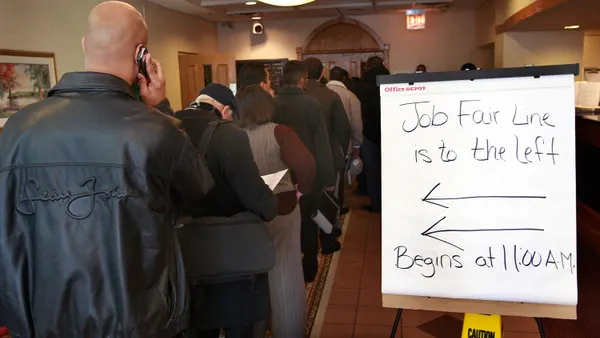As it turns out, Goldman Sachs may not be the only Wall Street bank using badge swipes as a tool to monitor in-office attendance.
JPMorgan Chase is doing much the same — feeding swipe data into "reports" and dashboards managers use to see how departments and employees are meeting company policy, Business Insider reported Wednesday. The outlet cited four bank staffers who spoke anonymously, and published screenshots of messages accessible only to managing and executive directors at the bank, describing the employee-tracking dashboard.
JPMorgan CEO Jamie Dimon, in his annual letter to shareholders this month, said roughly 10% of the bank’s employees can work remotely full time. About half of the bank's workforce is being required to return to the office five days a week. And the remaining 40% are allowed to work a mix of what the bank calls a "general expectation" of three days a week at their desks and two away.
"In all situations, these decisions depend upon what is optimal for our company and our clients, and we will extensively monitor and analyze outcomes to ensure this is the case," Dimon wrote in the letter.
At its inception, the bank pitched its hybrid work model as "increased flexibility" for its employees. But some staffers are finding the rigidity of the monitoring effort to be off-putting.
"At JPMorgan, nobody trusts you," a London-based tech employee told Business Insider. "The higher-ups don't trust you to do your job if they're not constantly watching you in the office."
Time in the office should be used "as constructively as possible" for tasks in which "being together is beneficial," the bank told staffers in a February email seen by Business Insider.
But that description may not fit every employee’s experience.
"I can't interact with people around me because of the [confidential] information I have," a senior asset-management executive told the publication. "I had been working remotely for a long time, and now I'm being swept up in this return-to-the-office mandate."
Likewise, the London-based tech employee told the publication the bank has demanded they come in at a time when their primary points of contacts, working from other time zones, are still asleep, making in-office days even longer.
The employee-tracking dashboard, described in screenshots sent to Business Insider, "provides the percentage of days employees were in the office out of the possible eligible days."
"Look at this and compare against what you're requiring for your team," a screenshot reads. "For example, if your team is meant to be in 3 days a week, this number should equal 60%."
An email shared with the publication details that managers are assembling "reports" to identify non-compliant employees, and that JPMorgan is "capturing this [data] centrally."
Goldman Sachs’ reported monitoring of staffers came to light late last month when The New York Post found a handful of the bank’s employees flagging the practice on Blind, a corporate message board that allows users to stay anonymous while verifying their employment through a company email account.
Roughly a dozen posts on Blind corroborated Wednesday’s report of similar practices at JPMorgan Chase.
"We are treated like children who don't want to do their homework and need constant monitoring," one commenter wrote, adding it "feels like every movement is tracked."
Two JPMorgan managing directors also came forward as sources to Business Insider. One touted the benefits of in-office work, saying "it's important to be in so I can communicate not just with my staff, but sales and trading as well." That executive conceded, however, "we're going to have to give some people leeway to let them work from home."
A second managing director struck a more resigned tone. "Nobody wants to be monitored but … It’s the company's data and we don't have a choice," the executive told the publication. "People want to be trusted to work from home and be treated as adults. But there's always a free rider."












